#Shade-tolerant summer plants
Explore tagged Tumblr posts
Text
Transform Your Backyard with Stunning Summer Garden Plants
Summer is the perfect season to turn your backyard into a vibrant outdoor oasis. With the right selection of summer garden plants, you can create a colorful retreat that thrives in the heat while supporting pollinators like bees and butterflies. Popular options include sun-loving perennials like daylilies and black-eyed Susans, tropical beauties such as hibiscus and canna lilies, and quick-growing annuals like petunias and marigolds.

To make your garden unique, explore creative flower names like snapdragons, cosmos, and bleeding hearts to add charm and personality to your space. Vertical gardening with climbing vines like morning glory or trumpet vine is also a great way to maximize space. For areas with limited water, drought-resistant champions such as lavender and Russian sage are excellent choices.
For a thriving garden, water wisely, feed your plants regularly, and prune to encourage more blooms. Consider themed gardens, like pollinator-friendly designs or fragrant gardens featuring jasmine and gardenia, to make your space truly memorable.
Start creating your dream summer garden today! Visit Flowers Name for expert tips and inspiration to make your backyard a lush, colorful paradise.
#flowersname#garden#Backyard garden idea#Best flowers for summer#Best summer flower names#Drought-tolerant flowers#Easy-to-grow summer plants#Exotic summer flowers#Flowering vines for summer#Heat-resistant flowers#Outdoor plants for summer#Shade-tolerant summer plants#Summer blooming perennials#Summer flowers list#Tropical garden plants
1 note
·
View note
Text
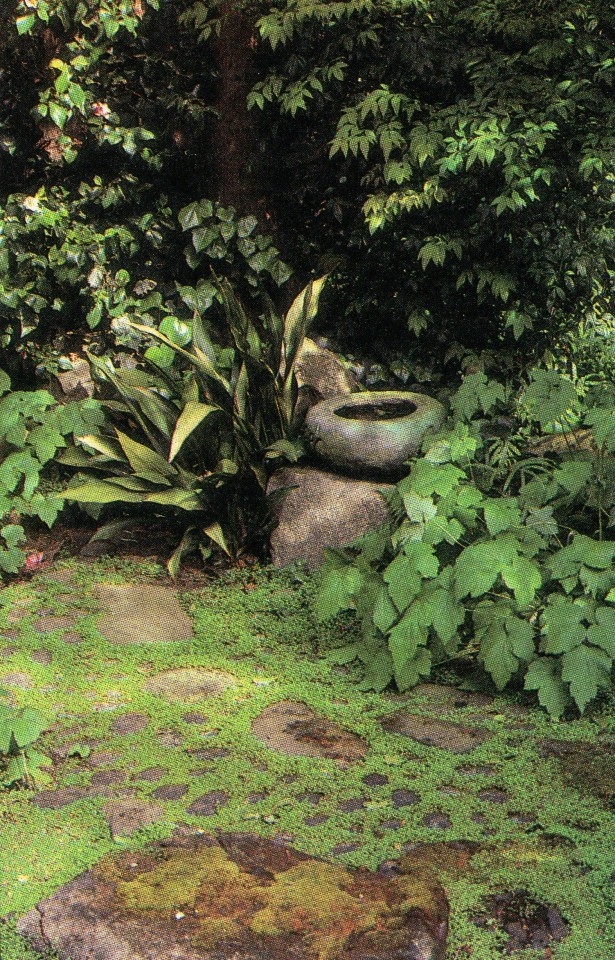
Damp shade. Anemone japonica and the tender Aspidistra elatior make up a summer grouping with a stone birdbath against a background of Hedera sp. The green ground cover plant is Helxine sp., which not only tolerates but requires dampness.
The Garden Book, 1984
#vintage#vintage interior#1980s#80s#garden#landscaping#landscape design#green#groundcover#stone#birdbath#shade#plants
1K notes
·
View notes
Text


Amaryllis belladonna
Information:
Kingdom: Plantae
Order: Asparagales
Family: Amaryllidaceae
Subfamily: Amaryllidoideae
Genus: Amaryllis
Species: A. belladonna
Amaryllis belladonna, the Jersey lily, belladonna-lily, naked-lady-lily, or March lily, is a plant species native to Cape Province in South Africa but widely cultivated as an ornamental.They appear as clusters of soft pink, 10cm funnel-shaped blooms sitting on top of long purplish-red and green stems, with up to twelve flowers blooming from just one stem.
Amaryllis belladonna are half hardy and can tolerate temperatures down to around -5C. It’s recommended to protect them from frost during harsh winters, and to start them off in sheltered conditions under cover at first.
Amaryllis belladonna requires very little attention and makes a truly unique display in the fall garden. Ridiculously easy to grow, all parts of this plant are poisonous, therefore it is diligently ignored by hungry deer, rabbits, and other critters.
The Jersey lily is a popular ornamental plant in gardens and parks, and it is also used in cut flower arrangements.It is known for its beauty and hardiness, as it can thrive in a wide range of soil types and growing conditions.
Tips to grow and care for A. belladonna:
A. belladonna should be planted with their necks at soil level, not submerged under the soil.
You’ll get your best results growing the bulbs in full sun, in moist, well-draining soil, although they will tolerate some light shade.
Plant them out about 10cm apart.
Wherever you’re planting them, make sure that the soil doesn’t get waterlogged.
If you do need to transplant them, do it in autumn after the plant has finished flowering and just as the leaves start emerging.
In a frost prone area, or areas that regularly hit below 2 degrees Celsius, plant them in front of a south facing wall, or in a pot that is placed in a sheltered area.
Once planted, it may take a year or so for the bulb to become properly established, so avoid disturbing the bulbs for a couple of seasons.
They prefer less water in summer, so in summer rainfall areas, ensure sufficient drainage.
#plant blog#plantblr#plantcore#plant photography#plants#flowercore#flowers#flowerpot#spilled ink#writerscommunity#light academia#dark academia#pink#naturecore#nature#photographers on tumblr#photo#photooftheday#photoshoot#photoblog#photography#botany#biology#plantbased#trees#forest#information#studyblr#beautiful photos#picture
28 notes
·
View notes
Text

Plant Profile: American Sycamore - Platanus occidentalis
No hot summer day at the creek would truly feel right without the solid white trunks of this wonderful species clinging to eroded banks. I've covered American Sycamore before but with winter coming it's the perfect time to spot their ghostly branches

The American Sycamore is a resilient fast growing yet strong wooded river's edge tree that can reach staggering sizes. The tree itself is easily recognized for its flakey bark that turns solid white as it stretches up into the branches with browns/greys/green splotches throughout. Sometimes called Buttonwood for it's seed ball fruit which are present throughout the winter, inside is full of fuzzy windblown seeds; as a kid I didn't know this and used to plant the balls in the ground whole, I never got a tree from it. The leaves are palmate, maple-like, typically more solid form yet a little pointed, staying light green and changing to a vibrant orange in the fall. These leaves can reach comically large sizes (See my hand compared to one below) and are also one of the preferred food sources for riverine invertebrates. The flowers are similar to the fruit, essentially rounded balls usually reddish in color which can be either male (erect stalks) or female (lax stalks) on the same tree.

P. orientalis (Aka Old World Sycamore) and London Plane (a horticultural hybrid between both species P. occidentalis × P. orientalis) are the closest trees visually to American Sycamore. If you're in the American east you won't really see the Eurasian Old World Sycamore, it's a Mediterranean species, you'll see London plane which usually has more shades of dull grey/tan brown/yellows in the bark (see image 4 below). Leaves of the London Plane are smoother, more distinct and flatter where the stem connects to the leaf (it looks like a norway maple leaf), P. occidentalis has its bottom two pinates stick out more at a sharper angle making the stem look further centered in the leaf (Image 3 above). Lastly the London Plane and Old World Sycamore usually have seed balls that come in pairs (just like us!) while American Sycamore has solitary fruit.

Native to the Eastern United States, the American Sycamore has a very large natural range. Reaching it's Northern most extent at the northern border of Massachusetts west to the Missouri River in Omaha, South to East Texas into San Antonio with a southeastern most range in (barely) Northern Florida. This tree is most commonly found in riparian zones or on alluvial river banks, best known throughout the Piedmont, sometimes in locations or elevations one would not expect. I've spotted it in Appalachia in Georgia and the Adirondacks of New York, on mountaintops in Pennsylvania and in Texas valleys, it can also grow as far south as Mexico.
In the many cities, Sycamore and the more common London plane (shown on a West Philadelphia street Image 5 below) grow so large they choke the sidewalk and cover our avenues. It can be tolerant of salt, drought, heat, and flooding. It has characteristics of early successional floodplain species without the weak wooded downsides. Sycamore grows fast, lives long and reach massive proportions (Image 6 is the largest Sycamore in CT, image by Marty Aligata) it's not unusual to find giants on historic colonial properties.


Culturally I can think of no better tree that captures that homey feeling of southern Pennsylvania better than a Sycamore. Those twisting shallow streams framed by massive pale branches dotted with lime green leaves floating gently in a humid breeze. Famed painter Andrew Wyeth in his painting "Pennsylvania Landscape" thought of no better tree to represent this better than our Sycamore, though he called it 'Buttonwood'. (Image 7 below courtesy of the Brandywine art museum) Most of my images come from the same Brandywine river of which the Wyeths based their studio (I liked hiking in Chester county).

Ecology: The American Sycamore is rather important within it's range, the root systems often prevent erosion along stream banks (see Image 1). The tree serves as nesting/dens for a variety of bird and mammals species as interior cavities are common on living trees. The tree is host to multiple moth species. The fallen leaves of American sycamore are some of the more common food sources for stream based invertebrates, second only to American ash species (Fraxinus) which have a low tannin leaf content.

Sycamore are often a pioneer species on disturbed floodplain sites, however, it will not disappear from these communities like typical early succession species as it can live an extremely long lifespan. The fast growth capabilities allow it to survive into later stages of succession and will outlive any competition. It has the third fasted growth rates of any eastern species, loosing only to Cottonwood and Black willow (both short-lived). Older Sycamores can grow massive, develop multiple trunks, grow sideways, and survive getting hit by a house in flood waters (Image 8 above along the Brandywine). I really can't emphasize enough this tree is a survivor.
In Appalachia studies have shown that Sycamore may be a useful species to grow in reclaimed coal mining sites due to its low leaf browse and growth rates (doi.org/10.1016/j.foreco.2010.11.018). Unfortunately the tree tends to also capture a lot of heavy metals in its leaf content.

Uses: Primary commercial uses for sycamore are for pulpwood, veneer, and butcher blocks. I was told as a scout that you can drink the sap as purified water in an emergency however I've seen people do this with cottonwoods and vomit, so I won't recommend. My indigenous peers don't have sycamore where they live so I have nothing to report on Indigenous relationships which I typically cover. This may be because the wood also rots easily, it is not edible and so its uses are limited.
Propagation: American Sycamore is super easy to propagate, In late autumn after leaf fall try to take a cutting from a young branch and place it in the ground. They can take without rooting hormone and can easily grow to 6' in a few years. The seeds are also reliable but have lower viability.

Landscape Value: I've beat to death the point that I love this tree and it will remain beautiful for centuries likely outliving us all. Sycamore has excellent form (image 9) and fast hardy growth, but has three suburban downsides: it can displace sidewalk, its shedding bark, and introduced disease. Plane Anthracnose Disease, a European pathogen, is affecting this species in the Northern portion of it's range. This won't often kill a sycamore but will form unsightly defoliation and cankers causing a 'witches broom' cluster of new growth branches. Londonplane is resistant to this disease however it does not have the same ecological value to the lower area of the food chain. This however has caused the American sycamore to become less common in nurseries.
So this has been my piece on the American Sycamore, look around your rivers and streams for those distinct white branches, pick up a sapling if you want a fast growing hardy native. Happy hunting :)
#American sycamore#plant profiles#Platanus occidentalis#buttonwood#native plants of the eastern US#Plane tree
15 notes
·
View notes
Text
so since I've basically seen all the seasons at my house now I've got a decent understanding of the micro-climate of my yard, and i need to document it somewhere so here goes:
front yard gets scorched. straight up. it doesn't really let up until 2-3 pm so i need full sun drought tolerant plants in the front area. (i dug some swales to redirect runoff from the foundation of the house, so its a little more moist than it was when we first moved in) this can be slightly mitigated by planting a couple dwarf trees in the very front area of the yard but that'll only help a little. i got a hardy hibiscus 'dark mystery' (Hibiscus Moscheutos, native perennial) that i plant to take cuttings of next year that has been loving the heat. This area i also plan to plant a bunch of milkweed (current varieties I'm planning to get are sandhill milkweed [asclepias Humistrata] green milkweed [Asclepias Viridis] Purple milkweed [Asclepias Purpurascens]) I'm also planning to get some native ornamental grasses to place around the entire property (including the front yard) some other plants i planning to plant are cardinal flower (Lobelia Cardinalis), liatris (liatris Spicata), Gaillardia (Gaillardia Pulchella), prairie sage (artemisia Ludoviciana), mountain mint (pycnanthemum muticum). more to be decided after i put this wave in. (definitely want some bee balm)
right side of the yard (by the house) is dark, cool, wooded, and wet. the rhododendron i put in was doing great until my brother in law took a lawnmower to it. :( but at least i can replace it. this is also where i have my feijoas (he also ran over them but they bounced back). probably will just add some rhododendrons & hydrangeas. i need to look up some more native shade plants for this area.
left side of the yard (by the house) gets even more sun than the front yard. i want to get a green house eventually (i have to replace all the windows in my house so I'll repurpose those for it) so this is probably the best place to do it.
backyard is large, part is dry and sunny, and towards the back is wooded. this is where i plan to put the fruit & nut trees i want. i need to thin out some of the less mature trees because they're extremely dense at the moment. (got a battery-powered chainsaw. i would have just borrowed my stepdads tools but hes convinced i would break them if i used them. :/ but at least now my father-in-law can borrow mine if he needs it) in the center of the backyard is where i have 2 12x4 gardens beds, and in the future i plan to add 2 more. this is where i have a lot of passionflower maypop plants, i transplanted some to the fenceline but i want an archway trellis as well. (i have watched probably over a hundred gulf fritillary caterpillars turn into butterflies, they're everywhere) the right side of the yard is where i plan to put the taller fruit & nut trees, (wont block sunlight) but i also want to get some dwarf fruit trees to place around as well. also this summer i saw lightning bugs in the backyard (!!!!!!!) so i plan to put in some grasses around an area that's like 12x12 ft across that dips down a few feet. (this area literally looks like a dried up small pond) i looked up how to use clay to create a natural lining for a pond, so this area will be good for lightning bugs, frogs, toads, salamanders, etc. this is in the lowest part of the yard, so its an optimal place for it.
this is just some basic plans for the future- i got a lot of seeds online so its not too break-the-bank expensive, and i get a lot of bushes and trees from etsy which can be great for saving money, despite the slight increased risk for mislabeled plants. i save money with this so i can get some nicer varieties of fruit trees that i really want (fuji apples, hosui pears, bing & rainier cherry trees).
my father-in-law really enjoys canning and preserving so I'm growing all the trees so i can give him some fruit to preserve (he lives in a very low-laying area, and a lot of it is swamp so he doesn't have as much room for fruit trees, his blackberry jam is amazing) also a guy my partner works with is into gardening as well (dudes he gave us so many peppers literally pounds of them) so i want to be able to return the favor with fruit. :) my mom and stepdad also have some fruit trees but I'm hoping to grow some that they don't have so we can trade.
ultimately i just want to grow as much food as possible and give it away to everyone who wants it, while also hosting the ultimate butterfly rest stop.
if you read this and enjoyed it, I'm glad! I'll post about these projects as i do them (which will be slowly) so i hope maybe this will inspire some of you :)
21 notes
·
View notes
Text
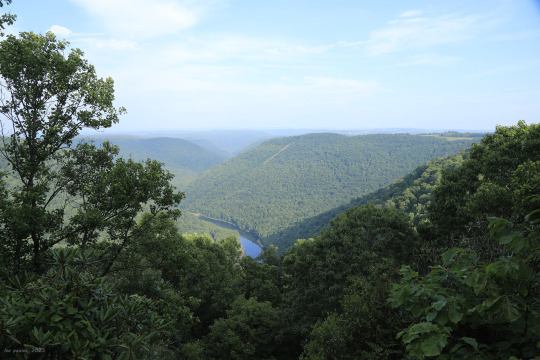

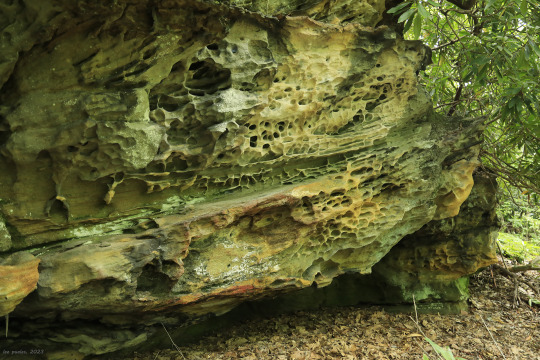

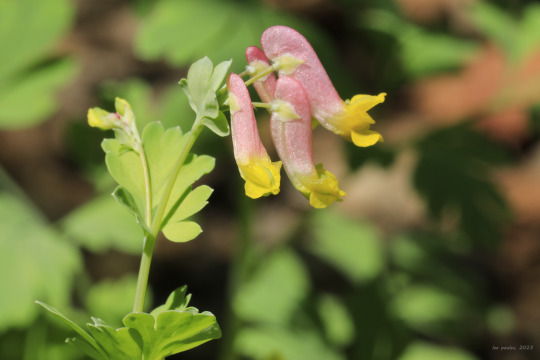
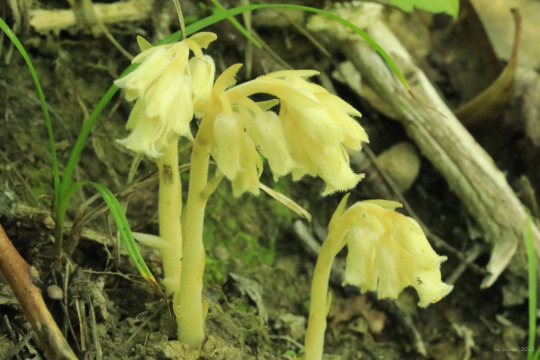


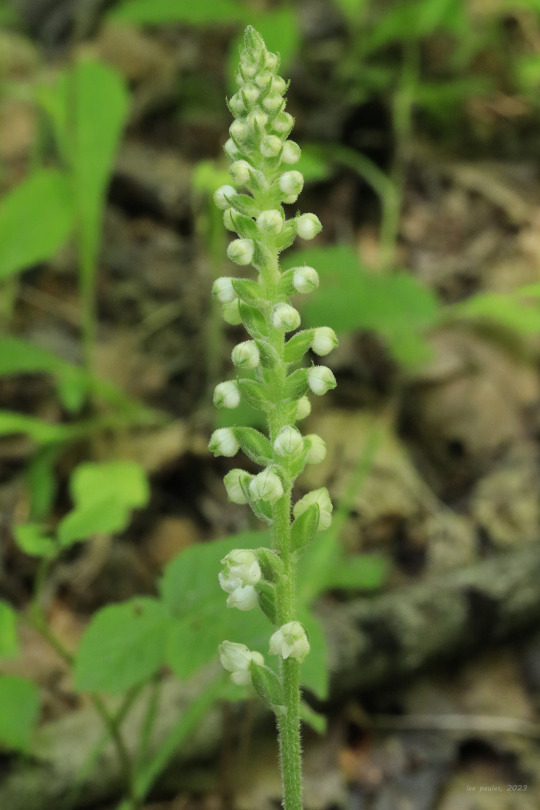
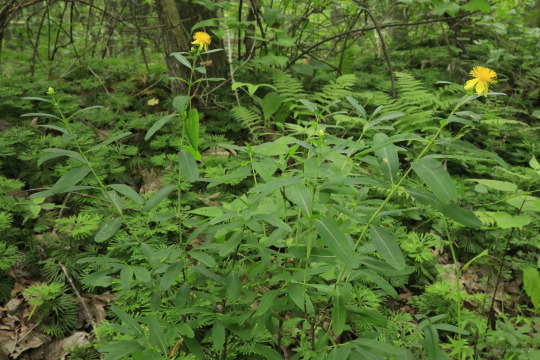






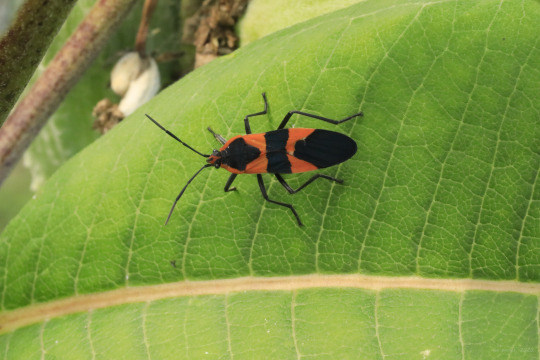
A hike in the Cheat River Canyon on a hazy, mid-summer day brings a great many rewards, both large and small.
From top: Fractured and pitted sandstone gives testimony to the canyon's ancient struggle with the elements; black cohosh (Actaea racemosa or Cimicifuga racemosa), whose towering flower spikes stalk the old woods like magical beings; the colorful rock harlequin (Corydalis sempervirens), an endangered fumitory that haunts the canyon's rocky outcrops; pinesap (Monotropa hypopitys), a parasitic plant closely related to Indian pipe; spotted St. John's wort (Hypericum punctatum), which is distinguished from the invasive St John's wort (Hypericum perforatum) by the numerous black dots on its flowers and leaves; downy rattlesnake plantain (Goodyera pubescens), a shade-tolerant terrestrial orchid that favors oak-hickory woods; shrubby St. John's wort (Hypericum prolificum), a mounding, deciduous shrub of open, sandy woods; orange-fringed orchid (Platanthera ciliaris), a stunning late summer beauty of Appalachia's moist meadows and open woods; a hummingbird clearwing moth (Hemaris thysbe) visiting a late-blooming milkweed; a silvery checkerspot (Chlosyne nycteis) drinking up the nectar of a butterfly milkweed (Asclepias tuberosa); an American green crab spider (Misumessus oblongus) stalking a black-eyed Susan for its next meal; a large milkweed bug (Oncopeltus fasciatus) being perfectly beautiful on a lazy summer day; and last but not least, a hulking patch of eastern Jack-0'-lanterns (Omphalotus illudens), which contrary to what field guides say have never glowed in the dark for me (I love the toxic little beauties nonetheless).

#appalachia#vandalia#west virginia#wildflowers#flora#summer#snake hill wildlife management area#cheat river canyon#chestnut ridge#fungi#insects#orchids#black cohosh#rock harlequin#pinesap#spotted st. john's wort#downy rattlesnake plantain#shrubby st. john's wort#orange-fringed orchid#hummingbird clearwing moth#silvery checkerspot#butterfly milkweed#american green crab spider#large milkweed bug#jack o' lantern#lepidoptera
174 notes
·
View notes
Text
Not really a good writer but whatever. bit out of character maybe.
(Some aidlyn food for the soul)
Bail
"Aiden, I'm gonna fall again!"
"You're not gonna fall, be confident!"
"Alright- I'm confident I'm gonna fall off this stupid thing!"
Ashlyn flapped her arms, desperately trying to regain her balance. She couldn't believe she'd let Aiden rope her into learning how to skateboard- she'd fallen on her ass more times than she could count in less than an hour, and she was pretty sure her tailbone was starting to bruise. At the very least, the skatepark was totally abandoned, so there were no witnesses to her repeat failures. Besides Aiden, of course.
She felt herself tilting forward, squeezing her eyes shut and raising her arms to block the fall, but it never came.
"Ah, gotcha!"
She blinked slowly, still disoriented from the sudden movement. Aiden's hands were tight around her elbows, the tip of his shoe jammed between the wheels. He smiled at her, the sunlight bouncing off his hair and his white teeth making him look even more boyish than usual. "Almost face-planted there, haha."
His head was inclined towards her, making his face a little too close for her own comfort. She looked away, her knees shaking. "You couldn't have caught me all those other times?"
"I didn't think you'd fall that much! You're so good at everything, I thought...", he trailed off, eyes flicking to the ground. "Sorry, we can stop the sesh."
Something bubbled up in her chest, indignation, maybe, or her own wounded pride. "No, actually, I think I'm getting it, let's keep going."
He stared at her, in a very particular way that almost made her feel transparent, like he was calling her bluff, like he could see right through her bullshit. "Are you sure? Your arms are kinda..."
She was pale, and she bruised easily, but the mottled skin was partially hidden by her freckles. "I'm fine. I've got a helmet."
It wasn't her helmet, but Aiden never wore his anyway. If she was going to keep this up, though, she should probably invest in a new one. There was a dent in the back, and she didn't really want to wear a helmet that had "Brain Bucket" scrawled on the side.
"Well, alright...do I need to explain it again?"
She thought about the time Aiden had told her he'd cracked his skull when trying to do an acid drop and wondered if the problem lied not with her, but her teacher. "Mm...yeah, if you don't mind."
He took her hand -a little spark running up her fingertips at the contact- and helped her off his board. "Right, so first, pick your stance. You seemed to prefer regular, but you can try goofy too, that's how I ride."
She couldn't help but snicker. It was so like Aiden to ride his board in the most uncomfortable looking way ever. "Hm! Regular is fine."
He nodded, helping her up, his leg out in case the board shot out from under her feet and shot off to crash against a rail. Which had already happened. Twice.
Easy...just relax and balance yourself.
She let out a shaky sigh, and to her delight, she was only slightly unsteady. "Hey, I'm-!"
She clamped her mouth shut when she felt Aiden's hands settle around her waist. "Try to align your feet over the trucks."
The only trucks she knew were the kind you drove, but she shifted her weight around, watching Aiden's face, until his eyes brightened and she assumed she'd gotten it right. She was finding it hard to concentrate, Aiden was a touchy guy, sure, but he'd never just grabbed her waist before. His fingers felt cold, even through her tank-top, even in the summer heat. Her cheeks slowly colored, a pretty shade of rose, which was mercifully hidden by her sunburn.
He laughed, a mischievous-looking smirk spreading across his face. "There you go! Did you just need me to hold on to you?"
He made it sound stupid and flirty at the same time, and she fought the urge to push him away because otherwise she was going to eat shit again. Her pride did not overrule her own tolerance to pain. "Whatever, shut up."
He let go of her waist, before quickly latching one hand on her arm. "Okay, so- don't tiptoe, I've seen you do that, you keep losing your balance like that. Put your weight on the front part of your feet."
Force of habit. Maybe it was too much ballet.
Slowly, very slowly, she pointed her left foot frontwards, the right firm against the deck. Aiden tentatively untangled their fingers, only the pad of his thumb brushing against her knuckles. "That wasn't too hard, was it?"
Smartass.
She scowled at him. "You can't talk too much, Mr. I-broke-my-arm-doing-an-airwalk."
He just laughed even more.
She scoffed, pulling her hand away from his. She put her foot against the asphalt to push herself forward. "See? Easy as-!"
The board shot forward, knocking her off her feet. "GAH-!"
"Ash!"
Aiden rushed forward to catch her, seizing her wrist and tugging her towards him. He tumbled backward as she crashed into his chest, hitting the ground with a dull thud. "Agh- shit...!"
She moved her hand to rub her head, only to be met with the hard plastic of the helmet. Well, now she knew why it was called a brain bucket- it felt like the organ was being rattled around in her skull, like a pile of shells or stones in a child's pail.
"Ash-! Are you alright?"
She let out a groan before opening her eyes, immediately started by the blood red of Aiden's contacts being so close to her. They were very close. She could see all the little details that she usually never paid any attention to- the almost purplish color to his skin around his sunken-in eyes, a lock of black hair curling over his ear, the only survivor of his constant bleaching, even the scar on his chin from playing with a pocket knife.
And his mouth. His mouth was extremely distracting.
"Um, Ash? Did you get a concussion or something?"
You want to kiss him.
The realization hits her with a dull terror.
Oh, crap, I want to kiss him.
Not even her sunburn can hide the mortifying shade of red that spreads across her face, and her hands are a poor substitute. She mumbles incoherently into her palms, her skin tingling from the heat radiating off her skin.
"Ashlyn...? I...What's happening right now?"
"..."
"...I...Can you say that again?"
I'm gonna kill him.
"...you...hh...mouth..."
Making sentences is hard.
"Did you hurt your mouth? Should I check it?"
Imagining Aiden touching her lips, his eyes roving carefully for any cut or bruise, makes it almost a thousand times worse.
"...!!!"
She peeks at him between her fingers, big forest-green eyes gleaming, almost magnetically drawn towards his own mouth. He follows her gaze, before stopping abruptly.
"Oh."
Oh, indeed.
"...Ash, would you let me...?"
He sounds so earnest. It makes her stomach feel weird, like there's a gaping maw inside her, or a hive full of crawling insects. Nothing pleasant like in the movies, unless butterflies in your belly were supposed to make you throw up.
She nods.
"Um...it's a little hard with your hands on your face," he says, not unkindly.
She closes her eyes, because she feels like she'll lose any semblance of bravery if she looks at him, and lets her arms hang loosely by her sides.
First, she feels the exhale of his breath on her lips, and then, a very soft, slight pressure on her mouth. Somehow, it feels exactly like a kiss, and yet, nothing like one. She doesn't respond, because she doesn't know how. The experience is quite neutral, made positive-leaning by the fact that it's Aiden that is kissing her.
Then he pulls away. "Um...sorry, I'm not really good at this stuff..."
Her eyes flutter open. He looks flustered, a pink hue bleeding into his cheeks.
"I mean, I've done it a few times, and every time it was super awkward-"
She purses her lips into a flat line, arching a single brow.
"-! Not that this was awkward or anything! I liked it- I mean, if you liked, I liked it-"
She watches him dig himself deeper into this hole of his own making.
"...I gotta teach you how to bail."
"...what's that?"
"A way to step off your board safely when you mess up a trick."
"But I don't know any tricks."
He sighs, runs his fingers through his bangs. "I know, but if you keep falling off and into me, I might spend more time kissing you than teaching you."
A small smile curves her lips. Well, one of those things interests her far more than the other, but he doesn't need to know which is which.
#sbg#school bus graveyard webtoon#sbg (webtoon)#school bus graveyard#aiden clark#ashlyn banner#aidlyn#aiden x ashlyn#if you saw this no you didn't#ooc probably
86 notes
·
View notes
Text


Antirrhinum majus (common snapdragon)
Snapdragons are noted for their very long blooming period and even in early November, I see them all over town. In optimal, cool-summer growing conditions, snapdragons will flower well from early spring to late fall. Antirrhinum majus is native to rocky parts of France and Spain and it's a crevice plant that prefers well-drained soil in a sunny spot. Snapdragons have been cultivated in gardens since Roman times but modern cultivars can tolerate far more shade. Just look at this healthy specimen, still 'beautifying' a boring, nondescript, downtown office building, long after all the surrounding flowers have 'thrown in the towel' for the year.
#flowers#photographers on tumblr#snapdragon#purple#November#fleurs#flores#fiori#blumen#bloemen#Vancouver#Canada
115 notes
·
View notes
Text
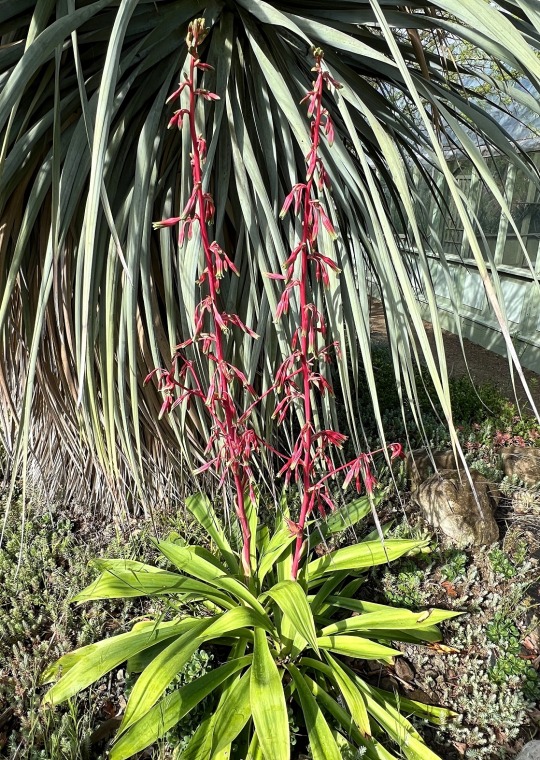
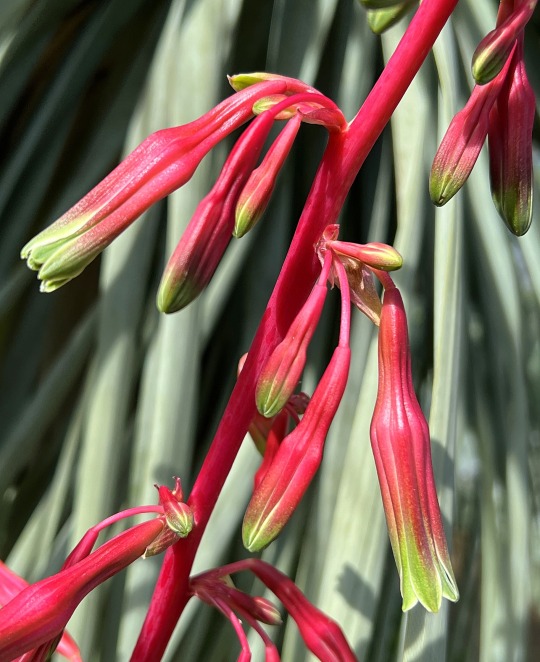
Beschorneria septentrionalis
Beschorneria is a small Mexican genus related to Agave, with plants typically fond in the mountains in forested areas, rather than in the drier lowlands. The most commonly grown species is Beschorneria yuccoides, but B. septentrionalis is a smaller plant with vivid green leaves, rather than glaucous-green like B. yuccoides. The flower stalk of B. septentrionalis is also a brighter red, and it remains attractive all the way through to the end of the summer as the large fruits develop. It does well in semi-shade (or in full sun in cooler coastal climates), and it is quite cold-tolerant to as low as 10° F (-12° C).
-Brian
17 notes
·
View notes
Text
Night-Blooming Plants

I focus a lot of my craft on lunar magick, so here is a list of my favorite night-blooming plants to put in my moon garden!
Moonflower
This vining perennial is perfect for vertical gardening using a trellis, pergola, or other supportive structure.
Maintenance: low
Water: drought-tolerant
Soil: well-drained soil
can become invasive — keep it in check by removing seed pods before they open
deer-resistant
Evening Primrose
Maintenance: very low
Water: drought-tolerant – little watering
Sun: full sun
Soil: well-drained soil
Night-Blooming Jasmine
Night-blooming jasmine can grow up to 10 feet tall, and its columnar shape is perfect for planting as a privacy screen or windbreak.
Maintenance: low
Water: water regularly
prune to shape
fertilize in summer every few weeks
Four O’Clocks
Maintenance: low
Water: drought-resistant
resistant to disease and pests
fertilize only if leaves turn pale green
Tuberose
Sun: full sun
Soil: well-drained soil
space them 8 inches apart in 2 feet of soil (to accommodate their growth)
add 3-4 inches of mulch to keep the soil moist
use slow-release fertilizer at the beginning of summer
Casablanca Lily
Maintenance: low
Soil: well-drained soil
perennial bulbs
deadhead blooms
Gardenia
Water: when soil feels dry (about twice per week)
Sun: full sun or partial shade
Soil: well-drained soil
flourishes in acidic soil
prune to shape
deadhead blooms
fertilize in summer every couple weeks
Night Gladiolus
Water: not much
Sun: full sun
Soil: well-drained soil
allow plenty of space
Night Phlox
Night Phlox is a low-growing ground cover.
Water: drought-tolerant, water regularly
Sun: full sun
Soil: well-drained soil
in-ground or in containers
Chocolate Daisy
Water: not much
Soil: well-drained soil
not much fertilizer or mulch
deadhead blooms
Evening Rain Lilies
Maintenance: low
Water: moderate
plant 6 inches apart
Foamflower
These perennial plants work great as a ground cover.
Maintenance: low
Water: keep soil moist
Sun: shade
deadhead blooms
resistant to deer, rabbits, disease and pests
Mock Orange
Reaching 10 to 12 feet high and wide, this is one of those night-blooming plants that works perfectly as a privacy hedge around your moon garden.
Maintenance: low
Water: when soil is dry
winter-hardy
fertilize yearly with compost, not nitrogen.
Dame’s Rocket
While grown as a biennial, the Dame’s Rocket can last for years because of its self-seeding nature.
Maintenance: low
Water: water regularly
deadhead blooms
resistant to disease and pests
Like what you see? Consider supporting me! ko-fi.com/thatdruidgal
6 notes
·
View notes
Text
Plants for the chronic over-waterer
So you’ll often see guides and rec-lists for plants that require little water and attention, and just generally ‘thrive on neglect’. But what about us anxious, hovering plant people whose most common way of accidentally offing a plant is by over-loving and over-watering them?
(Before we get into it, let me preface this by the usual disclaimer: a plant’s water needs wildly depend on its environment. I live in the continental temperate zone of Europe, the average humidity level inside is 30-40%, so what I write may or may not apply to your conditions. Watch your plants closely - if you’re reading this post I know you would anyway - and proceed accordingly.)
Look no further, here’s a list of plants that are virtually impossible to over-water:
Fittonia sp.
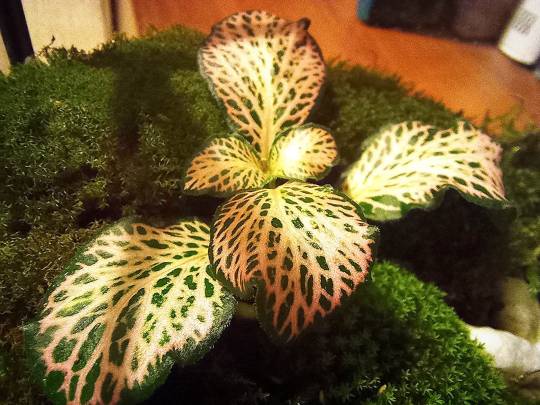
Fittonia are extreme divas in room conditions but perfect angels in a terrarium. They will not tolerate a missed watering day, they’ll immediately start to droop. If you’re lucky and you catch them in time they’ll perk up and go on like nothing happened, but the margin between this and irrevocable crisping is a slim one.
Ferns in general
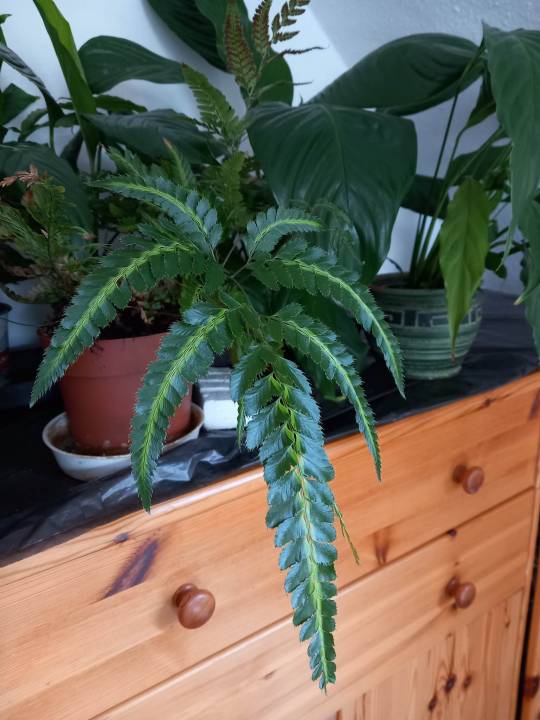
Of course the details of care depend on the species, but most ferns prefer shade and hate to dry out. I usually water all of mine twice a week, and so far they are doing okay.
Dionaea muscipula - Venus flytrap (and most carnivorous plants)
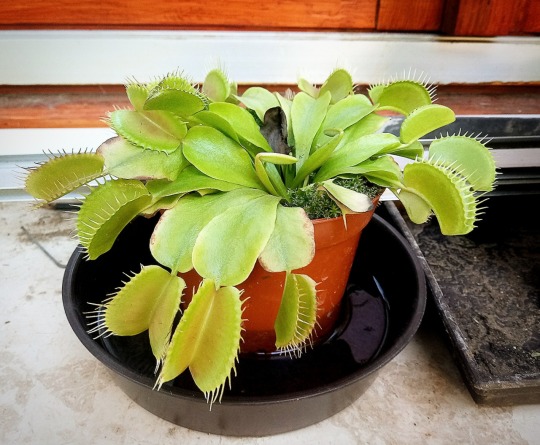
Plants usually resort to eating animals when they live in bogs, where the soil is acidic and extremely poor in nutrients. What bogs also are, is wet, and so these plants need to literally stand in a pool of water all day, every day and are therefore quite literally impossible to over-water. (At least in the summer. Over-wintering depends on whether the plant is temperate or tropical.)
The only downside is that they are really sensitive to water quality. No minerals (and no fertilizer!) allowed, only rain or distilled water!
Marantha leuconeura
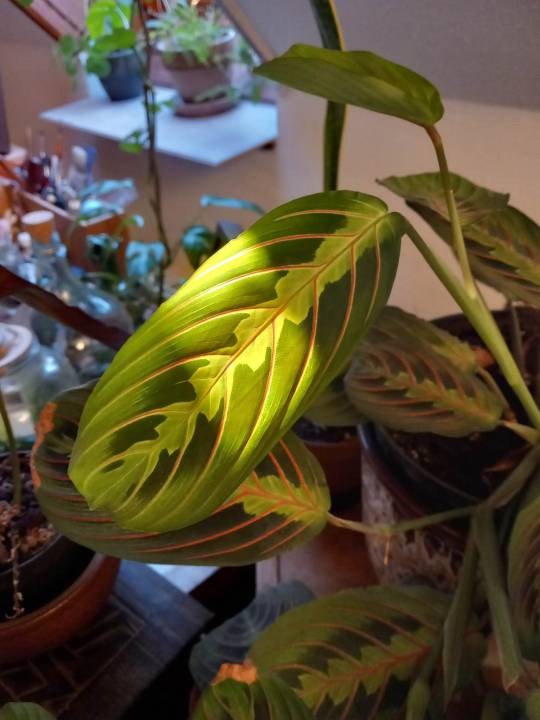
Honestly I’d say the entire Maranthaceae counts, but I only have experience with Marantha, and I’m told the rest (like Calathea) are more difficult. These, once you get the water right (twice a week for me), aren’t that bad. They don’t need a lot of light either.
What you do have to keep in mind, is to give them soft water - like collected rain water. They are sensitive to the minerals in the tap water and since they can’t properly secrete them, they’ll store them away in the tips of their leaves, which will thus crisp up.
Jewel orchids
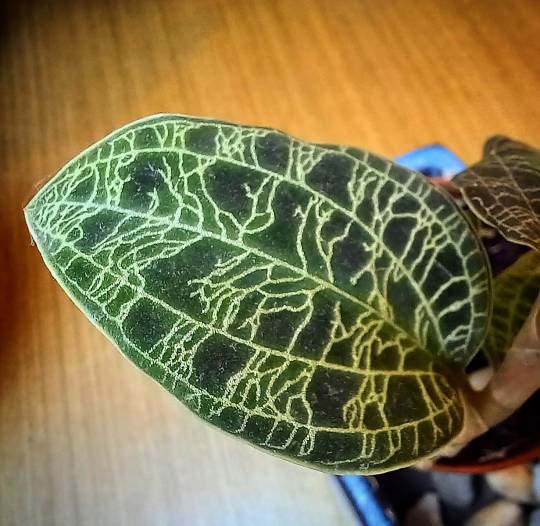
The one I have (Macodes petola) does well in a shadier spot, in normal room conditions. I mean I do run a humidifier once a day, but it’s not in a terrarium. It’d do well in one though, so if you’re looking to furnish a terrarium, this is a good choice. The only thing you gotta keep in mind if you keep it out in your room is to always keep the soil moist.
Mimosa pudica
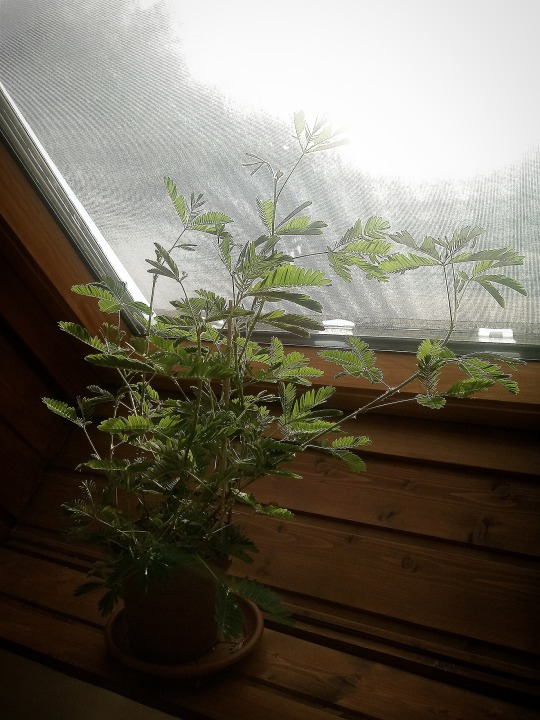
This is a fun and interesting plant, what with the cute moving leaves, but it is the divaest of all divas. On a sunny, dry summer day it may have to be watered twice a day, and it’ll go into hysterics, crisp up and throw leaves if you’re late by five minutes. The good news is that as long as you do get around to watering it, it’ll bring new shoots and keep growing, it’ll just litter your room with dead leaves in protest.
It also prefers lots of light.
Spathipyllum sp. - Peace Lily

Like ferns, these do well in shadier spots. If exposed to too much light, they’ll keep bringing small, light green leaves, but they’ll flower regularly. (They feel like their lives are in danger so they hurry to procreate before the end.) In the winter they need to be watered about once a week, in the summer more like every two days.
The nice thing about them is that they are very vocal about their needs but, unlike the Mimosa and the Fittonia, don’t immediately, irrevocably crisp up, they’ll just droop. Water them and they’ll perk right back up.
#plant posting#plantblr#plant care#plant community#plant collection#houseplants#indoor plants#fittonia#peace lily#fern#carnivourousplant#marantha#orchid#mimosa
77 notes
·
View notes
Text
An Overview of Plants: Cinquefoil
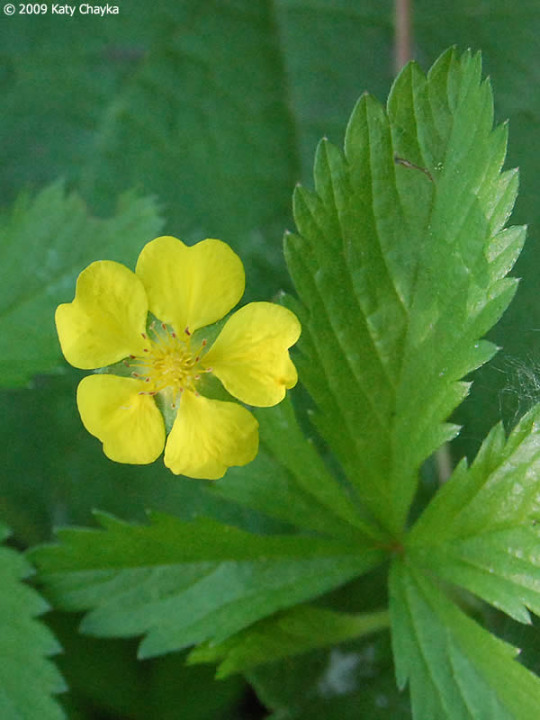
Name: Cinquefoil (Potentilla genus, many varieties)
Description: Often, it has yellow flowers, though some are white with a yellow center, or pink. It always has five heart-shaped petals, with the spaces between looking like a star. It has leaves with spiked edges, and the leaves grow in clusters of five that look like a star as well. Easily mistaken for a strawberry plant.
Cultivation: It is a warm-weather plant that grows best from late spring through fall. It prefers partial to full sun, and can up to grow anywhere between two and four feet. When planting it, plant in the cooler part of spring, with the root balls about six inches deep and three to six feet apart depending on the grown size of the variety. Tolerant to many kinds of soil, as long as it drains well. Yellow leaves are a sign the soil is iron deficient, and are something to look out for. When watering, keep evenly moist during the first growing season - after that they are rather drought resistant. Too much shade, waterlogged soil, and high humidity may lead to fungal diseases or rootrot.
Harvest: The best way to harvest the plant is by pulling the whole thing in June/early summer. Dry it in a shady place. Though, if the stems or wood are needed you can use the trimmings from prunings - prune by cutting back the stems to the wood in early spring before leaves grow, cutting back only a third of the plant at maximum.
Folklore: In Europe, cinquefoil was used for prosperity and love workings, and sometimes as a form of spiritual or magical protection. In some parts of Europe, it has been tied strongly to witchcraft - believed to offer protection against it and as an ingredient in the infamous ‘flying ointment’ used by witches. Romans also believed it had ties to the god Mercury, and would use it in devotional incense.
Magical Properties: Used primarily in luck, love, prosperity, and non-material protection workings. Worn as a talisman, it is said to warn off malicious spirits. Also known for its connection to fae magic, and for its uses when communing with them.
Medicinal Properties: Mainly used to treat mild inflammation, so it has been used for sore throats, inflammation-based fevers, and menstrual cramping mainly. But there is some evidence it can also be used for diarrhea and certain skin conditions.
Recommended Amount: There is no known recommended amount, so be mindful when using, and consult a doctor and/or pharmacist before using regularly. When making tea, one tablespoon is generally enough.
Warnings: Not enough about its interactions are known, so avoid if pregnant or breastfeeding to be safe, and consult a doctor and/or pharmacist for interactions with other medications.
*This is a page from my grimoire. I am not a health professional, nor do I claim to be. This is just a compilation of information I’ve gathered from various sources I trust, and any medical decisions should be made by individuals with the help of a trained professional.
An Overview of Plants - more plants
12 notes
·
View notes
Note
i didn't see it in the lexicon, but is there a word for "shade" ? i know there's shadow and dark, but shade is more specific
There's two. There's Horrl, and Maema. They both refer to very different things.
Horrl is understorey. It's where shade-tolerant plants like fuchsia, yew, and moss grow best. It's where small animals live, and where ThunderClan likes to hunt. It's shaded by definition, and thus is usually used as the -Shade suffix you see in the books.
Mapleshade's name, Gessqahorrl loses a LOT of meaning in English. A more accurate translation would be Sycamore Understorey. She lurks in the undergrowth of a sycamore patch, leaping out to strike!
Maema is the shade provided by things that block out the sun, which is a relief on summer days. It's a word related to light and darkness, not to any specific location, which is probably the word you were looking for.
This is the one more often used in prefixes, and by RiverClan and WindClan which don't have understories in their territories. Shadepelt of RiverClan was named Maemaborrl, not Horrlborrl. I also renamed Shadepelt 2, who is now her grandchild in BB, their name is now Shademuzzle. Maemamawa.
New words here:
Sycamore (Acer pseudoplatanus) = Gessqa
Muzzle (The entire mouth area, chin, snout, and mouth) = Mawa
38 notes
·
View notes
Text



Frogfruit, frogfruit, everywhere there's frogfruit!
What is frogfruit?
It's a grass that is native to the southern portion of North America. It spreads from coast to coast, then south from Oklahoma into Mexico. It was here before us and was the most common grass before the US decided to turn our yards into pretty lawns.
Frogfruit works best in full sun, but will survive in partial shade - if the tenderals will wonder in that direction and live, then so be it. This native grass has a counterpart - horseherb. Horseherb grows in mostly shade, but can tolerate sun - again, if the tenderals wonder in that direction and can survive, then it was meant to be. Both are also pollinator plants - you guessed it, they flower all summer long.
In my yard, I do not have enough shade, I'm in sun 6+ hours a day. so frogfruit is my choice of native grass for now.
Here's some background on this little patch of sunshine. I live in north TX (USA) and my yard is primarily of clay origin. I decided to throw down some cardboard, spread a bag of mulch and planted a 4 inch container of this juicy little plant. That was in May of 2023. I watered it 3x a week during the summer with the alloted times set aside for water restrictions and I didn't mow it that first summer.
Now look at it!
She spread her tenderils in all the right directions, she has stretched to both garden borders and is making her way around the wheelbarrow/container garden. I'm trying to nudge her more into the middle of the yard now. I've tried propagating this little plant so that I can plant plugs around my yard and help it spread some more and also move some of the plugs to the front yard for certain areas to grow. I will admit that propogating them is not as easy as the many YouTube clips say it is. So far I'm 1 out of 10 in the success rate. But I'll keep trying.
So if you live in the southern portion of the US/northern Mexico, give this little plant a try for a traditional lawn alternative.
#green witch#garden witch#urban gardening#green witchcraft#texas garden#magic herbs#urban garden#witches of tumblr#texas native plants#native landscape#native plants#mother nature
5 notes
·
View notes
Text
Help me pick my garden!
Hello Tumblr, it is almost spring, and that means it's ✨landscaping time!✨
I bought a house last May, moved in in June, and took one look at the back yard before declaring it a "next year problem." Alas, the next year is upon us.
What should I plant?
Here are the rules:
Nothing that cannot tolerate heat; temps here get over 100 pretty regularly in the summer.
Nothing that cannot tolerate sun. We have, just... so much sun... and even with the house providing a bit of shade, it's going to be too bright for most shade-loving plants.
Nothing that is fatal to cats! Our cats are indoor-only, but there are a couple of Orange Kitties that roam the neighborhood whom I wouldn't want to do any harm. (Cleo haaaates them. She gets all poofy-tail when they come by; it's adorable.)
And for guidelines...
Historically I pretty much only garden things you can eat, but since there's so much room and it's all mine now, I'm open to changing that!
Perennials are favored over annuals, but suggestions for both are welcome.
Shrubs are also acceptable, since I have a front yard that's going to require some landscaping, too. It looks like it's too hot here for raspberries, but maybe I'll find an equivalent?
I have asparagus, tomatoes, and hot peppers on the list already. What else should I plant?
13 notes
·
View notes
Text
Gardening goals for 2025!

Now that I’ve been in our new house for a year (well, it’ll be a year in February) I’ve figured out all the little microclimates of my yard and what will do best where! I’ve mentally divided up my yard into zones based on their microclimates.
Zone 1 (front yard)
This is the hottest part of the yard! In the front I plan to do a prairie style garden, with a couple of smaller trees and some shrubs to help keep the sun off the house, hopefully this will lower energy usage when it comes to AC in the summer. This will also muffle road noise, because we’re right up against the road and we get a lot of 18-wheelers on our road.
Zone 2 (left side of the yard)
I’ll use this as a transition area, continuing the prairie style garden but add a few more fruit & flowering trees/shrubs. I need trees/shrubs here because in my backyard I have seen lightning bugs and I want to shield their habitat from any light coming from the road, because any light disturbance can disrupt mating rituals. But I also get a lot of sun in this area too, and I need to again protect the house from the sun and also put species that like full sun. There’s a gate on our fence that opens into the neighbors yard and so if I get a lot of fruit it’ll be easy to bring her some!
Zone 3 (right side of the yard)
The property next to us is unused woodland, so this area doesn’t get a lot of sun and it stays pretty moist. This is where I put my pineapple guavas and I want to add some more shade loving plants. Definitely want to put some rhododendrons here. (I had one, but my brother in law beheaded it when he offered to come and cut the grass in the yard over the summer 😔)
Zone 4 (mid back yard)
This is the unwooded part of the back yard. I’ve put a couple of raised garden beds for my annual fruits and veggies, and I plan to eventually have 4 garden beds, and an outdoor lounge area. (Hoping to find an outdoor dining set at a thrift store, I’ve seen a couple at habitat for humanity. If my stepdad ends up getting a new set, I’ll ask for his old one)
This is where I’ve started planning some paths and in-ground garden beds, and this is where the yard will transition into a woodland/food forest garden. The backyard gets just about as hot as the front, and while a lot of plants in the summer enjoy the heat they don’t enjoy that much heat. I also want a moon gate for my purple passionflower vines that grow here.
Further to the back where we have more trees is the hole that I plan to put a wildlife pond, and where I see the most lightning bugs. I plan to just use the clay method to seal it (no plastic!) and even if it just becomes an ephemeral pond that’s still great for wildlife. I’ll add some native grasses to help the lightning bugs (they use grass to perch on during mating season) this is another moist area of the yard (which explains the lightning bugs, they like moisture during larval stages) so I’m hoping for some frogs & toads in the future.
Zone 5 (very back of the back yard)
(Nearly) Fully wooded, just not too overly dense in most areas. I have to get rid of some Chinese privet, Chinese honeysuckle, and Bradford pears that have germinated but it’s mostly natives. I’m going to thin the thicker areas and plant some native plants for wildlife and some nut trees. It’s far enough from the house that any large fruit trees will go back here. (Hurricanes are no joke, especially after Helene I want to be really cautious of keeping small trees near the house and large ones as far away as possible) this is the area that the rattlesnake incident happened! The paths from the mid-backyard will continue back here, and this is where I can put more shade-loving/tolerant native wildflowers. (Like our native iris, love her)
So the goals?
-get some native grass seed (big bluestem, little bluestem, purple love grass. Pink muhly grass, etc. I’ll take any suggestions from my fellow southerners)
-thin overcrowded trees
-use those logs ^ to line the paths (I get paths, and insects get homes, win/win!)
-get some more wildflower seeds! I’ve collected the more common ones, now I need to figure out some of the forgotten species that local wildlife might need
-get some baby trees. I posted before that I get a lot from Etsy, and that will continue. I tend to find native species fairly cheap on there. I also need to keep a look out for any deals going on at gardening centers.
-clear out invasives. The invasive privet is enemy #1 and it’s on sight cause they grow fast
13 notes
·
View notes